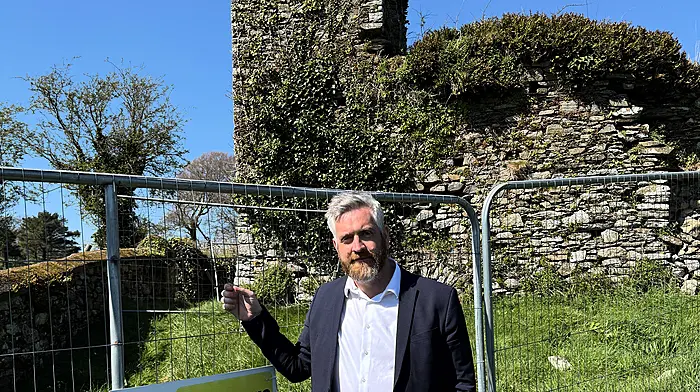THE story of a forgotten peninsula has been etched in stone at South Reen.
The area, near Union Hall, is reputed to be one of the first hit during the Famine, but it may also have been one of the worst hit because it left Reen without a community.
‘The village was decimated,’ said John Kelly, an internationally acclaimed artist, who now lives on a 13-acre holding at South Reen Farm with his wife Christina Todesco Kelly.
‘There were 200 people living on this peninsula but by the end of the Famine most of them were dead,’ he said.
Those who survived were given work on the famine relief scheme. For their labours, they were fed from the famine pot which is still on the property today. The huge soup pot is housed in the Tate Glass Cathedral, an interpretation of the Tate Modern in London that was built by a glasshouse company in the UK and shipped to Reen.
Bob Geldof, patron of The Folly Fellowship in England, got to hear of it and asked to visit Reen Farm when he was in West Cork.
Folly or not, the scale model of the Tate Gallery is clearly an art installation because despite its name South Reen Farm is anything but a working farm.
John and Christina have turned their 13-acre holding into a veritable sculpture park that includes the Think and Thank Garden.
It’s a walled garden that includes the Tate Cathedral, as well as the Nichola Marshal Cummins letter. The Cummins letter, which was published in 1846, was addressed to the Duke of Wellington and it outlines the devastation the famine caused at South Reen.
In July 2020, the NM Cummins letter was etched in stone and laid in the floor of the Tate Cathedral, which in itself is a nod to the Westminster Cathedral, and brings with it its own degree of solemnity.
A second, smaller tablet featuring an extra from a letter from Dr Crowley was also installed and it makes for particularly grim reading as it is a factual account of burying the dead.
The latest development – a work in progress – is called the road to nowhere, a reference to the relief roads built during the famine.
One of the new four plaques contains the names of the locals who worked on the Myross relief road.
Another acknowledges The Famine Story, written by local historisans Terri Kearney and Philip O’Regan, which was published in 2015.
The third features an extract from The Great Famine in Skibbereen, a book by Peter Foynes. The final tablet features an extra from The Great Hunger, which was written by Cecil Woodham-Smith.
It describes how ‘roads were laid out which led from nowhere to nowhere.’
One road that will have purpose, however, is the road on Reen Farm which will lead from a large wall within the Think and Thank Garden to the Tate Cathedral. It will serve as a kind of pilgrimage in memory of those who lost their lives during the famine.
All of this will be open to the public, but not until it is safe to do so, post-Covid-19.









